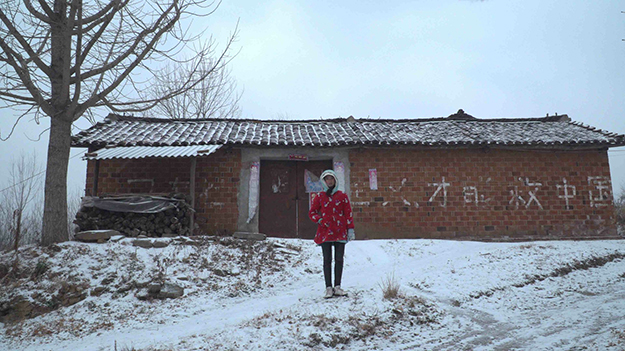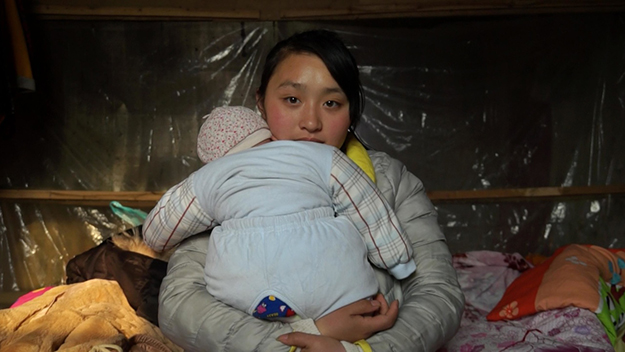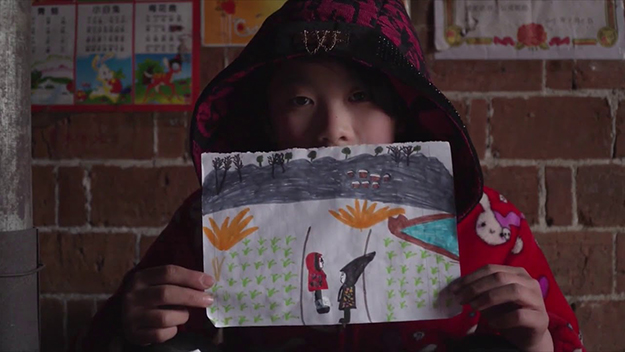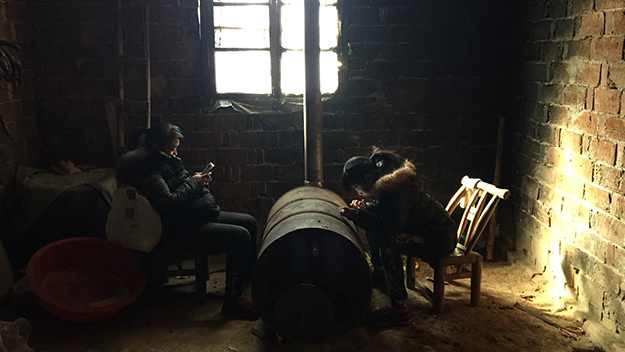Interview: Mengqi Zhang

Self-Portrait: Window in 47 KM (Zhang Mengqi, 2019)
Sheets of rain clear the streets of people. Trains are cancelled, the road is blocked. Despite the typhoon, the cinemas are full. This is Yamagata, a small city in the mountainous northeast of Japan. The 16th edition of its biannual international documentary film festival (YIDFF) has just began.
YIDFF is known for programming politically engaged non-fiction film across several competitions, special programs, and retrospectives. The festival began in 1989 as a centennial celebration of Yamagata city, and documentarian Ogawa Shinsuke was pivotal to its establishment. Twelve years earlier, Ogawa had left Tokyo with his filmmaking collective, Ogawa Pro, and moved to the mountains above Yamagata. Ogawa Pro wanted to learn how to grow rice and film the process. They were not retreating from political activism, as some thought at the time, but rooting political concerns about ecology, farmers’ livelihoods, and globalization, in the landscape. Their project combined hands-on farming and filmmaking, oral history, and storytelling. They distributed the resulting series of idiosyncratic documentaries throughout Japan, bypassing commercial film networks by organizing screenings in village halls and homemade theatres. Ogawa’s belief in alternative networks led him to envision a filmmaker- (as opposed to industry-) oriented festival in Yamagata. Conscious of a preponderance of European and North American film festivals at the time, he wanted Yamagata to support Asian as well as local and global documentary communities. At YIDFF’s inaugural edition, Filipino director Kidlat Tahimik drafted an “Asian Documentary Filmmaker’s Manifesto” that committed to maintaining a network for sharing ideas and challenges. To this day, the festival’s “New Asian Currents” is its most vibrant strand. In 2017, the festival earned Yamagata the UNESCO title “Creative City of Film.”
Because of the two-year interval between editions, YIDFF’s International Competition includes comparatively older titles. This year, audiences could revisit and recontextualize films such as Miko Revereza’s No Data Plan or Wang Bing’s Dead Souls. The prevailing tone of the festival is thoughtful, generally slower paced than at other similarly sized festivals. There are no red carpets, no exclusive parties. Most of its funding comes from the local government and not corporate sponsors. Q&As are engaging; experts and non-experts alike ask questions that feel genuinely inquisitive.
This year, films in the International Competition and “New Asian Currents” largely fell into two thematic categories. There were films about political borders, and there were films about rural folk history. Zhang Mengqi’s documentary, Self-Portrait: Window in 47 KM was one of the latter.
Self-Portrait is the eighth in a series dating from 2011, when Zhang began filming her father’s village in Hubei province, central China. The village lies 47 kilometers from Suizhou city, hence its peculiar name. Devastated by the Great Famine of 1959-61 and suffering now as its younger generation leave to find work in the city, the village is a palimpsest of political and social history. Party slogans remain in traces on houses’ walls; inside, Mao Zedong’s portraits still hang from them. In the film, Zhang visits elderly villagers accompanied by a young girl who draws their portraits. The voiceover testimony of an 85-year-old man who survived the famine and sits for his portrait forms the film’s central narrative.
Born in 1987, raised in Suizhou and educated in Beijing, Zhang found herself detached from rural life and her grandparents’ generation. In 2011, she joined filmmaker Wu Wenguang’s Folk Memory Project. A founding figure in Chinese independent documentary film, Wu recruited young filmmakers and dispatched them to villages across China to interview survivors of China’s Great Famine. Tens of millions of people died during the famine that was incurred by economic and social policies of Mao’s Great Leap Forward. The famine is glossed over in official Chinese history; Wu’s project confronts it directly. His project space in Beijing, Caochangdi Workstation, hosts filmmaking workshops and other collaborative activities.
Wu met Ogawa in 1991 and was the first recipient of YIDFF’s Ogawa Shinsuke Prize two years later. Wu, Ogawa, and Zhang share a belief in documentary being a mode suited to the detail, ambiguity, poetry of everyday life. Ogawa described the slow pace at which farmers told stories as “village time.” He understood village time to relate to traditional, natural and seasonal paces, and used long takes and sync sound to match it. Zhang’s extended interviews and landscape shots reflect a similar sense of time and history. Between interviews, her camera lingers on Hubei’s wintry landscapes as if, if it looks hard enough, it might reveal what Patrick Keiller’s protagonist Robinson describes as “the molecular basis of historical events.” And, like Robinson, Zhang believes that by looking at landscape and its history, she might better understand her present and future situation.
Two years ago, Zhang’s Self-Portrait: Birth in 47 KM was shown in YIDFF’s “New Asian Currents.” Birth explores generational differences between a grandmother who experienced famine and her granddaughter, a migrant worker. That same year at YIDFF, Zhu Shengze’s Another Year chronicled the lives of rural elders and their urban offspring in Hubei province. Parallels with Zhang existed not only in location and subject matter but also in a formal language of long takes and uninterrupted speech. But whereas Zhu’s framing was meticulous, her composition painterly, Zhang’s Self-Portraits feel fluid, rougher. Zhang’s project advances with a rawness and scale reminiscent of Wang Bing’s comprehensive, often devastating, oral histories of modern China. Indeed, it was during an intermission for Wang’s eight-hour-plus Dead Souls, screening at Yamagata, that Zhang spoke with Film Comment.

Self-Portrait: Birth in 47 KM (Zhang Mengqi, 2017)
Your Self-Portrait series is filmed in one village. Do you see the memories and experiences you collect in 47 KM village as unique, or representative of many others?
Both. I am interested in filming specific people—this girl, this uncle—because otherwise their lives will pass by unknown. But I am also interested in how their stories help me understand a wider situation—for example, how an entire generation views itself in relation to the previous one, and to land, and to labor.
You include a dedication to your village at the end of the film. For whom do you make film?
Go back to the name, 47 KM. Nobody knows this village. I’m filming there to prevent 47 from being just a name on a map. It is in this sense that my films are for the village. Were it not for these films, no one would know about life there. Maybe someone abroad will see the film and visit the village. I mean, visit the village and not just Beijing. I’m currently building a house for myself to stay in while filming there and I’ll use it for gathering, workshopping, screening films. It will be a bit like Wu Wenguang’s Workstation. Somewhere for villagers to come and collaborate with me.
47 KM village is also called Diaoyutai and it has had two or three other names in the past, when Mao’s land reforms reshuffled rural districts and governance. What the village is called depends on who is talking. The idea of calling it 47 KM for the films came to me when I was given instructions of how to get from Suizhou to the village. My mother told me to ask the bus driver to stop 47 KM from the city limits: that’s where the village was. The village existed from the start as a kind of marker of relation to me. 47 KM marks the start of my journey, my self-portrait. Incidentally, now that Suizhou has grown, the village is only 42 KM from the city.
Who lives in the village?
My grandfather, before he passed away, and some other relations. As is common, the grandparents’ generation remain in rural areas while younger generations live in the cities to work. Some families send their young children to the villages to live with their grandparents. In Window, the young girl who draws people’s portraits—her name is Fang Hong—is unusual because her parents have remained in the village.
I only live in the village during filming. I come from Suizhou and lived in Beijing, studying contemporary and folk dance. By folk I mean Uighur, Tibetan, Mongolian dance. Alongside this training I got involved with Wu Wenguang’s Folk Memory Project and participated in non-fiction filmmaking workshops at Caochangdi Workstation. That’s how I started making film and went to 47 KM village with my camera.
In Window, we see you dancing silhouetted in front of a window. After your screening of Birth at YIDFF 2017 you danced in the auditorium. Why do you combine dance and film?
It’s something we often do at the Workstation. In one of my earliest projects I had my mother tell me about my birth while I danced an interpretative response. I was interested in how recounted experiences—my mother’s memories, in this example—can be combined with imaginative performance. In the Self-Portraits, histories I’m being told are often very heavy. Dance and imagination lighten them.
Do you dance and screen films in the village?
Sometimes. I showed my first film in combination with a performance in some trees where I hung old photographs. I like performing in the village because it feels informal, direct. Villagers come right up to me and say, ‘no, your movement here is not right, it should be more like this.’ I often use gestures taken from farming activities, and they recognize them.
I visit families’ homes to show my films. This creates opportunities for small groups to gather. People have few chances to congregate otherwise. We share food, people reminisce, and enjoy seeing themselves on screen.

Self-Portrait: Sphinx in 47 KM (Zhang Mengqi, 2018)
How do they respond to your films?
They think what I’m doing is strange. This was especially so the first three or four years I visited the village. Villagers don’t have much exposure to art or dance. They see dancing on television for New Year’s celebrations, that’s about it. They find it hard to understand what I’m doing as art, but they enjoy my visiting them. Early on, people were shy to talk or collaborate. Children in the village were faster to respond. Fang Hong is almost 16 now and has her own camera. She inspired me to think about the future: hers, my own, the village’s.
Window begins with a long sequence in which we see a Maoist political slogan painted on the wall of a house. The characters have faded or been scrubbed away, and the sentence reads incompletely as “…ism.” You film Fang Hong in front of this slogan and ask her what “-ism” she would have China follow now, if not Maoism. She says, “People.” What do you say?
“People” is a good answer. Meeting people. Visiting people. Bringing color into dark rooms. Young meeting old. I don’t like words that end in “-ist” or “-ism.” But the question is good. What now? The most important thing for me is continuing. The project continues. The project and my life in tandem.
The old man who recounts painful memories of famine and hard labor is just one example of many villagers you film who share harrowing experiences. What ethical factors do you take into consideration as you’re filming and editing testimonies?
I think a lot about working with memory. Old villagers have become eager to talk. I always have the camera with me, it’s like another limb. Another old man in the village never remembers me but always my camera. By now I don’t need to ask people questions, they just talk. Sometimes their outpourings are painful. They trust me. When I’m editing, I’m selective. The woman talking about delivering her own babies, for example, in Birth. Her story speaks to a wider topic of motherhood and survival, so it was important to include. When another woman was describing the particularities of her divorce, I left them out.

Self-Portrait: Birth in 47 KM (Zhang Mengqi, 2017)
In Window, the old man sits inside his house, before a portrait of Mao. We return to this shot throughout the film as the sun sets, blanketing him, Mao, and memories of “New China” in darkness. What interests you about people’s houses?
Houses seem to want to talk to me. I sit in and outside them imagining what memories and stories they house. The landscape holds memories too. In Window, I film the old man sitting in silence. We hear him speaking from recordings I made over several months. It’s as if the house itself is speaking. This sequence is extended; time is very important to me. Beijing is so hectic, and the village is calmer, has a totally different time. Why is everyone in my generation so fast and the cities so nervous? I answer this by going to the village and understanding its history. Long takes capture the landscape’s slower pace and help me reflect upon the very different pace of the city.
The project has been going nearly a decade. Taken as a whole, the films extend to twenty or more hours. I’m reminded of Wang Bing’s films. I know you’re watching Dead Souls today. Is Wang an influence?
I don’t know his films too well, but I’m moved today, hearing all the testimonies in Dead Souls. I really admire what Wang is doing. Wu Wenguang’s films are a strong influence on me. He’s making sense of why China is the way it is today, based on its history. Wu’s Investigating My Father [2016] is inspiring for the way Wu considers how his father coped with change and hardship after 1949. Before getting to know Wu, I didn’t think about history and the present the way I do now. For Wu, every little detail about his father’s life is important. Through detail, history comes alive.
Another film that’s inspired me recently is Social Investigations, a documentary by a little-known filmmaker called Peng Wei. On one level, the film is about burial and recent changes in Chinese law that make burying bodies difficult. But on another level, it’s about filmmaking in China today. Throughout the film, Peng argues with a friend about how they should make the film, their motivations, their constraints. It’s a rough and ready kind of film but very interesting in its directness.
In my films too, I try to be as direct as possible. I record everything myself, on a handheld digital camera with an on-camera mic, and sometimes a tripod. I want to learn more about sound and color, but technical aspects aren’t that important to me. The important thing is how to continue talking with this village.
Becca Voelcker is a PhD student in Film and Visual Studies at Harvard University, and a freelance film critic and programmer.







